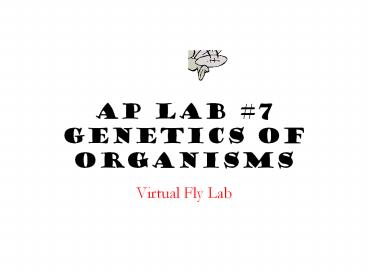AP Lab 7 Genetics of Organisms - PowerPoint PPT Presentation
1 / 11
Title:
AP Lab 7 Genetics of Organisms
Description:
AP Lab #7 Genetics of Organisms Virtual Fly Lab Instructions Instructions: 1. Find the Fly Lab Manual in your box of materials use the access code found in the manual ... – PowerPoint PPT presentation
Number of Views:333
Avg rating:3.0/5.0
Title: AP Lab 7 Genetics of Organisms
1
AP Lab 7Genetics of Organisms
- Virtual Fly Lab
2
Instructions
- Instructions
- 1. Find the Fly Lab Manual in your box of
materials use the access code found in the manual
to register for the lab at www.biologylabsonline.c
om - 2. Read through the introduction and objectives
for the lab. - 3. Then click START LAB
3
Your Choice
- Monohybrid cross
- Create a monohybrid cross between a wild-type
female and male fly with sepia-colored eyes.
Sepia is a nonlethal recessive allele located on
Chromosome III.
- Dihybrid Cross
- Design a dihybrid cross by selecting and crossing
an ebony body female fly with a male fly that has
the vestigial mutation for wing size.
Sex-linked cross Design and perform the following
crosses to examine the inheritance of sex-linked
alleles in Drosophila. Cross a female fly with a
tan body with a wild-type male.
4
Now What?
- Based on what you know about the principles of
Mendelian genetics, predict the phenotypic ratio
that you would expect to see for the F1 offspring
of this cross and describe the phenotype of each
fly. - (In other words, use a punnett square)
- Select 10,000 flies as the number of offspring
for this mating. Click on the Mate button.
- Scroll down to see the wild type offspring.
Record this on your data sheet. These offspring
are the F1 generation. - Note The actual number of F1 offspring created
by FlyLab does not exactly equal the 10,000 - offspring that you selected. This difference
represents the experimental error introduced by
the FlyLab. - Are the phenotypes of the F1 offspring what you
would have predicted for this cross? Why or why
not?
5
Next Step
- To set-up the F2 generation, click Select under
the F1 female and Click Select under the F1
male. And mate - them.
- Record F2 offspring use the scroll buttons to
view all the phenotypes of the F2 offspring. - Are phenotypes of the F2 offspring what you would
have predicted for this cross? Why or why not?
- From pg. 85 of AP Biology Lab Manual
- Statistics can be used to determine if
differences among groups are significant or
simply the result of predictable error. The
statistical test most frequently used to
determine whether data obtained experimentally
provide a good fit or approximation to the
expected or theoretical data is the - chi square test.
6
kahy-skwair
- Determine the number of degrees of freedom (df)
based on the number of different phenotypes minus
1. - The null hypothesis states that there is no
statistically significant difference between the
observed and expected data. - If our cross resulted in a phenotype ratio that
was expected, we would seek to accept our null
hypothesis. - If our
- actual data do not fit the expected ratios, then
we would reject the null hypothesis. - The minimum probability for rejecting a null
hypothesis is 0.05, so use this row in the
chi-square table provided - in your manual. These results are said to be
significant at a probability of p0.05, which
means that only 5 of the - time would you expect to see similar data if the
null hypothesis was correct. - Fill in the chi-square chart on your data sheet
with the data for the F2 cross.
7
Chi What?
- Lets do a sample analysis.
8
Suppose you preformed a simple monohybrid cross
between two individuals that were heterozygous
for the trait of interest.
- Results of a monohybrid cross between two
heterozygotes for the 'a' gene.
Our expected numbers due to our prediction
through a punnett square
25 AA 50 Aa 25 aa
10 AA 75 Aa 15 aa
The phenotypic ratio 85 of the A type and 15 of
the a-type (homozygous recessive). In a
monohybrid cross between two heterozygotes,
however, we would have predicted a 31 ratio of
phenotypes. In other words, we would have
expected to get 75 A-type and 25 a-type. Are our
results different?
9
Calculate the chi square statistic x2 by
completing the following steps 1. For each
observed number in the table subtract the
corresponding expected number (O E). 2. Square
the difference (O E)2 . 3. Divide the
squares obtained for each cell in the table by
the expected number for that cell (O - E)2 / E
. 4. Sum all the values for (O - E)2 / E. This
is the chi square statistic.
10
We now have our chi square statistic (x2 5.33),
our predetermined alpha level of significalnce
(0.05), and our degrees of freedom (df 1).
Entering the Chi square distribution table (pg.
86) with 1 degree of freedom and reading along
the row we find our value of x2 5.33) lies
between 3.841 and 5.412. The corresponding
probability is 0.05ltPlt0.02. This is smaller than
the conventionally accepted significance level of
0.05 or 5, so the null hypothesis that the two
distributions are the same is rejected. In other
words, when the computed x2 statistic exceeds the
critical value in the table for a 0.05
probability level, then we can reject the null
hypothesis of equal distributions. Since our x2
statistic (5.33) exceeded the critical value for
0.05 probability level (3.841) we can reject the
null hypothesis that the observed values of our
cross are the same as the theoretical
distribution of a 31 ratio.
11
You Can Do It!































